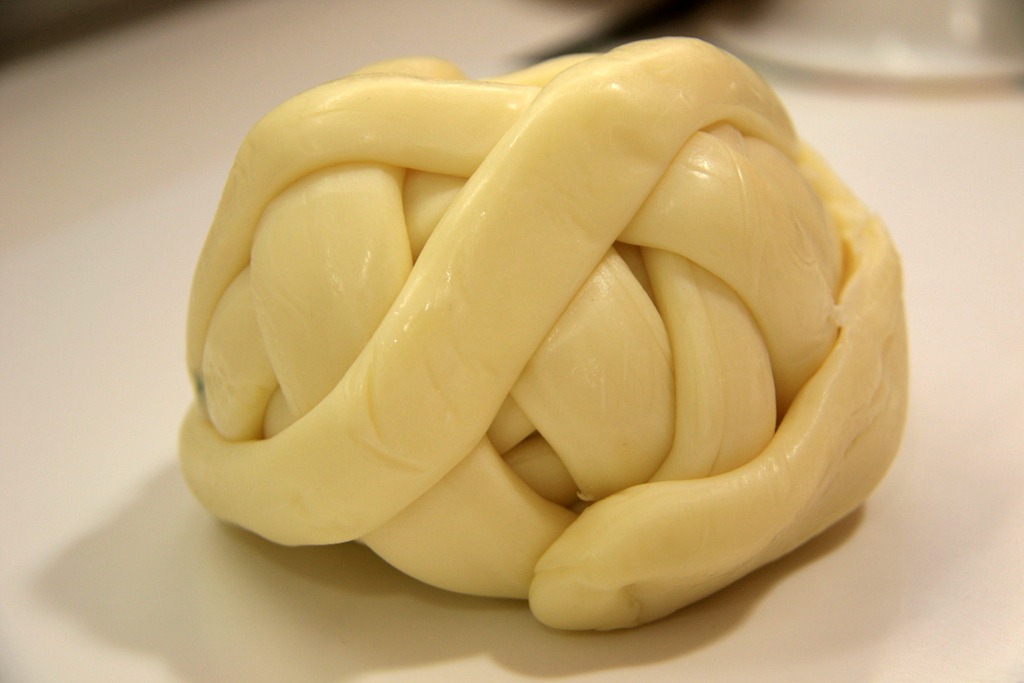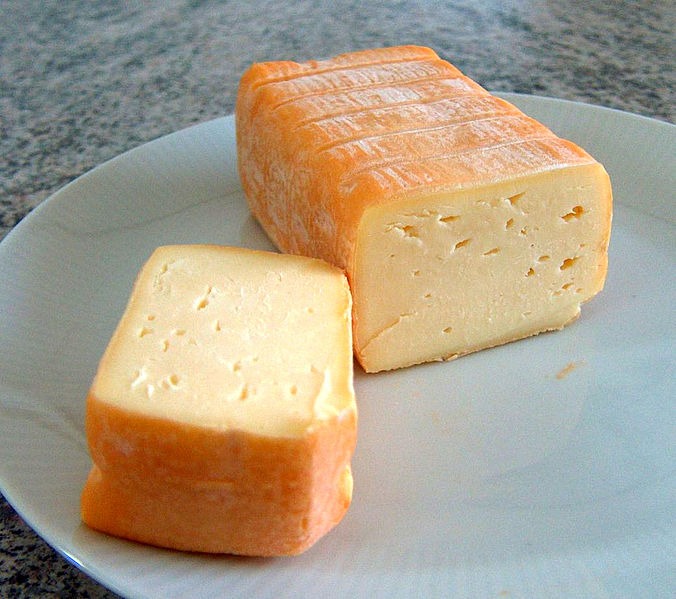The texture of semi-soft cheeses falls somewhere between that of soft cheeses and that of hard cheeses. During processing, between 36 and 45% of the water in these cheeses was taken out. This is done by cutting the curds, which are formed when milk curdles, and then pressing out all the whey, which is a liquid byproduct of the curdling.
The resulting cheese is soft and easy to cut, but just firm enough that it can’t be spread. In other words, these are great cheeses for snacking or dessert.
Since these cheeses haven’t been aged for very long, they still taste fresh and milky, with nutty, earthy, or tangy flavors.
Manufacturing Process
One important thing about how these cheeses are made is that they are always made with whole milk, sometimes with cream added, but never with part-skim milk. This makes them soft and creamy, and it also helps them melt well. There are two kinds of semi-soft cheese: those with a dry rind and those with a washed rind. Surface-ripened cheeses, also called washed-rind cheeses, are treated with a bacterial smear on the outside and then washed with a solution to help the smear grow. With a washed rind, the cheese ages from the outside in. Cheeses with a dry rind are aged without anything being added to the outside.
Performance
You can shred, slice, or cube semisoft cheeses. Cheeses that are halfway between hard and soft melt well and can be used in hot situations, even in the microwave. They stretch a little and can be browned and broiled.
Key Applications
They are great for sauces, soups, casseroles, and roulades because they can melt. They are easy to mix with other cheeses to make gourmet pizzas with a signature taste. Many of them can be made with different flavors, like hot peppers, herbs, spices, and more. They can also be cut into pieces, which makes them great for sandwiches and ready-to-eat snacks.
Key Benefits in Foodservice and Prepared Foods
Their mild flavors make them great for carrying other flavors. Mixes well with other semi-soft cheeses or cheeses with stronger tastes. Good qualities for cutting and shredding. Cheeses that are very flexible and can be used in many ways, from the cheese course to the oven and from fast food to fine dining. Cubes, shreds, and slices that are ready to use save time and money.
10 Popular Semi-Soft Cheeses Around the World
1. Bocconcini
Bocconcini is a type of Italian cheese that comes from the region of Campania. It looks like mozzarella and is about the size of an egg. It is made from the milk of water buffaloes or a mix of buffalo and cow’s milk. These small balls have a texture that is half soft, creamy, elastic, and springy. They taste mild, buttery, and slightly sweet.
The name “bocconcini” comes from the shape of the cheese, which looks like little bites. It is best to eat it fresh or put it on pizzas or dishes with a lot of vegetables. White wines go well with it.
2. Pepper Jack
Pepper Jack cheese is made in Monterey, California, which is in the United States. This popular kind of Monterey Jack cheese has a spicy kick from the jalapeo peppers it is made with. It is made from cow’s milk and has a natural rind that hides a creamy, smooth, and open texture.
It smells like herbs, and it tastes sharp, spicy, and buttery. The cheese has a lot of water in it, so it’s easy to melt. Pepper Jack is often added to sandwiches, pizza, omelets, and casseroles to make them taste better. It’s also good for making Mexican dishes like quesadillas, enchiladas, and nachos.
3. Limburger
Limburger is a semi-soft, smear-ripened cheese made from cow’s milk that has a strong smell. It was first made by Trappist monks in the Duchy of Limburg in the 19th century. This area is now shared by Germany, the Netherlands, and Belgium.
Germany is where most Limburger cheese is made these days. It has a washed rind that is the color of straw, and the taste is mild, grassy, and kind of like mushrooms. As it ripens, the texture changes. At first, it’s crumbly and hard, but after six weeks, it gets smooth and creamy.
4. Fontina
Fontina is a semi-cooked cheese that has been made in the Aosta Valley since the 1100s. It is made with raw cow’s milk from the Valdostana Pezzata Rossa cattle breed. Fontina can be semi-soft or firm, depending on how long it has been aged, and its flavor can range from mild, sweet, and nutty to strong and very sour.
This delicious cheese is usually used to make Valdostana-style fondue, but it can also be enjoyed in other traditional Aosta Valley dishes like Valpelline Soup with Lardo d’Arnad or Costolette alla Valdostana. It goes well with light, fruity wines.
5. Oaxaca Cheese
Cow’s milk is used to make Oaxaca cheese, which is white and not too soft. The stringy texture of the cheese is what makes it stand out. It tastes savory, mild, buttery, and creamy, which makes it perfect for quesadillas, empanadas, and tlayudas. Because the cheese melts well, it is often used in many baked dishes.
It gets its name from the southern Mexican state of Oaxaca, where it was first made. The process for making pasta filata cheese came from Italy. Dominican friars who settled in the state of Oaxaca brought it to Mexico.
6. Reblochon
Reblochon is a semi-hard, pressed cheese that weighs about 500 grams and is made in the French departments of Savoie and Haute-Savoie from unpasteurized cow’s milk that needs to age for at least 15 days. An old story says that it was made because a farmer turned his milk into cheese to hide some of it so that he could pay less “milk taxes” to the owners of the pasture.
The outside of reblochon is yellow to orange, and the inside is ivory. Its rind can be eaten, and the cheese tastes nutty and a little bit fruity. The smell is strong and reminds me of cellars where it has been kept to age. It tastes great on baked potatoes and melts well.
7. Scamorza
Scamorza is an Italian cheese made from cow’s milk and shaped like pasta filata. Two balls of cheese are made and then stuck together. One ball isn’t as big as the other. It has a texture that is halfway between soft and hard and is chewy. It tastes like milk and smoke. Two balls of cheese are put on a string for two weeks to age. This is why the cheese is called “beheaded,” which is what its name means.
Scamorza that has been smoked is called scamorza affumicata. Scamorza is often compared to mozzarella, but it tastes much creamier and sweeter and is much drier. Since it melts well, it’s best to bake it, but you can also put it on pizza or lasagne.
8. Roquefort
Roquefort is a French cheese made from full-fat, unpasteurized sheep’s milk. It is one of the best cheeses in France. Before the cheese is pressed, the spores of Penicillium roqueforti grew into blue veins that run through its body.
It is so tasty and popular that Emperor Charlemagne liked it, and people in the area call it the “cheese of kings and popes.” Roquefort has a moist rind on the outside and a crumbly, creamy, tangy, intense, complex, sharp, and salty white paste that is marbled with blue mold on the inside.
9. Stilton
Only the English counties of Derbyshire, Nottinghamshire, and Leicestershire can make Stilton cheese. It’s one of the few cheeses that freezes well, and people call it “The King of English cheeses.” There are three kinds of Stiltons: white, blue, and mature or vintage.
White Stilton is, as its name suggests, a white, cylindrical cheese made from full-cream, pasteurized cow’s milk that forms its own crust. It tastes sour, fresh, and creamy, and its texture is open and crumbly. The crust is moist and smooth.
10. Halloumi
Since ancient times, Nicosia, Limassol, Larnaca, Famagusta, Paphos, and Kyrenia have been making halloumi cheese. It is made from fresh, full-fat sheep’s or goat’s milk or a mix of the two, with or without cow’s milk (traditionally, cow’s milk is not added).
The milk comes from goats, sheep, or crossbreeds of these animals that are native to the island, as well as cows that were brought there in the last century. The curd is folded so that it will fit better in the whey containers. During the folding process, the mint leaves are put between the layers of curd. This lets the mint give the final product its smell.
Conclusion
Semi-soft cheeses are loved by both serious foodies and casual snackers because they are creamy, rich, and very tasty. Most of the time, these cheeses have more moisture and a milder flavor than harder cheeses. They also come in a wide range of types to suit everyone’s tastes. Some good semi-soft cheeses go well with a sweet fruit plate, while other creamy semi-soft cheeses are best spread on toast.


